B.J. pushes aside the ferns as he approaches the edge of the muddy river in central Guam. Hunched over and carrying a cane, he is looking for the spot where he was tied to a tree decades ago. Mosquitoes descend ferociously with every step he takes. Apart from the gushing water, the jungle is quiet.
"Look, if you yell, nobody can hear you," he says. "Or if anything happens to you, nobody will know."
The river looks completely different from that day 46 years ago when B.J. says he was raped repeatedly by Fr. Louis Brouillard, a priest and then-Boy Scout leader. B.J. was only 11 years old, and remembers the water was calm. The trees weren't pressed so hard against the water's edge.
"He had me strapped to one of these trees like this," he says, pointing to the trees next to him. "He went down there, right, and then he started to slowly swim back here, right, and he got up here to me, right? That's when everything changed."
B.J. is one of more than 100 men and women who have filed lawsuits against the Archdiocese of Agana on Guam alleging abuses that occurred between the 1950s and 1980s.
Sex abuse scandals have roiled archdioceses throughout North America for the last two decades. But only in recent years has the church in this small, intensely Catholic U.S. territory begun confronting its own legacy of abuse.
The magnitude of the claims is staggering. According to a recent USA Today analysis, Guam, with a population of only about 160,000, has a per-capita rate of abuse claims more than five times higher than in Boston. So far, 16 priests have been accused of sexual abuse. About a third of them are deceased and some have left the priesthood. One was defrocked.
The church kicked off settlement discussions in Honolulu in September and has compiled a list of dozens of properties to help pay for the costs of the claims.
But the lawsuits only scratch the surface of years of political infighting and bitter drama within Guam's Catholic Church that initially triggered many of the charges. The community has for two decades been split between traditional Catholics and those who follow the Neocatechumenal Way, a branch of the church that works to evangelize lapsed Catholics.
About 85 percent of Guam's population is Catholic, a higher percentage than even Italy. The church's influence is so pervasive that all members of the Guam Superior Court have recused themselves from the cases involving the archdiocese.
And the scandal's impact extends thousands of miles away from the island. Dozens of plaintiffs are spread throughout the U.S., and priests who are accused of abusing children on Guam went on to be accused of molesting kids in other states like Hawaii and Minnesota.
The Boy Scouts are also named as a defendant in cases involving Brouillard, who was a Scout leader.

Candles flicker in the Dulce Nombre de Maria Cathedral Basilica in Hagatña, Guam. (Honolulu Civil Beat/Cory Lum)
For some on Guam, the turmoil calls into question what it means to be Chamorro on an island where religion is for many inseparable from indigenous culture.
At the center of the scandal is the highest-ranking Vatican official in Micronesia: Archbishop Anthony Apuron, who has been accused of sexually abusing four boys and is the subject of multiple civil lawsuits.
Apuron, once among the most powerful men on Guam, has maintained his innocence and is awaiting the outcome of a secret canonical trial in Rome regarding the abuse allegations. A federal judge in Guam recently ruled against Apuron's motion to have the civil lawsuits dismissed.
More than half of the complaints are against Brouillard, who is in his late 90s and lives in Minnesota. Despite admitting to sexually abusing as many as 20 boys, he still receives a $500 monthly check from the archdiocese.
Even if most cases settle, that won't necessarily bring closure to the plaintiffs. Many are in their 50s and 60s. But they still struggle with the pain of recounting the stories to their loved ones for the first time.
Advertisement
'Why is this happening?'
Despite their trauma, some are looking for healing in the church whose priests once failed them.
Faith has helped B.J. process the rape, the memories of which are excruciatingly vivid. He remembers hiding by a tree near his house for days afterward, nursing himself, and praying both to the Christian God and to Chamorro ancestors: "Guela and Guelo, help me, why is this happening?"
The nightmares never stopped. When his parents heard him screaming about the jungle and river, they worried he was possessed by taotao mo'na, ancestral spirits that live in the trees. They brought him to a suruhana, a traditional Chamorro healer, who said something had happened to B.J. but she couldn't help.
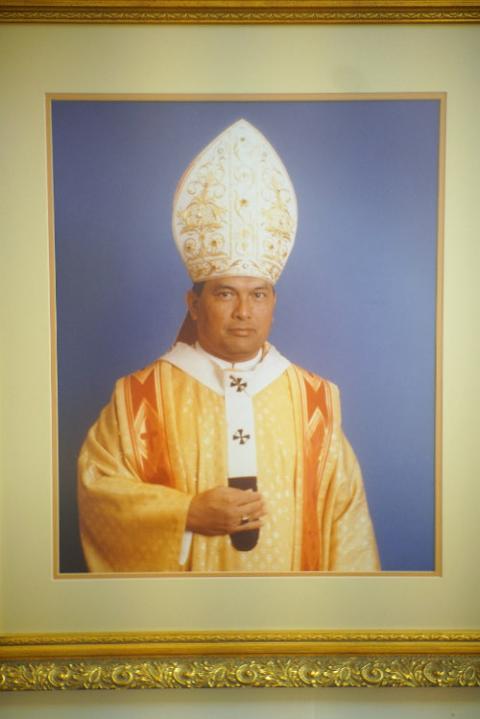
The Vatican suspended Archbishop Anthony Apuron after four people accused him of sexual abuse. (Honolulu Civil Beat/Cory Lum)
Like many others who've finally come forward with their claims, B.J. couldn't bring himself to tell his parents what actually happened. They were so strict and devout that he was terrified they wouldn't believe him or would punish him.
He still considers himself Catholic. "The only support I have is, I have Jesus Christ," says B.J. "Guaha Yu'us."
In Chamorro, that means "I have God."
Going public
Guam has been part of the U.S. for more than a century. Souvenir shops sell mugs proclaiming the island as "Where America's Day Begins" and the U.S. military owns or leases a quarter of the island.
But in many ways, the island feels culturally more similar to former Spanish colonies in Latin America and the Philippines.
Every village celebrates fiestas for saints, a tradition derived from when Jesuit missionaries converted the Chamorro people in the 17th century and reorganized their communities around churches.
On a late afternoon in August, when the village of Piti is celebrating its annual Feast of the Assumption of Our Lady Festival, Roland Sondia sits in a pew with his family listening to the tetsa (prayer leader) lead the rosary.
The church is decorated with colorful banners proclaiming, "Biba Santa Maria" and there's a strong smell of incense. After the rosary and Mass, Sondia joins the other parishioners in a procession leading to the statue of Mary. Singing and praying along with the group, he carries his granddaughter, who is dressed up like an angel, on his shoulder.

Parishioners pay their respects during a Mass held in honor of the Assumption of Our Lady in Piti, Guam. (Honolulu Civil Beat/Cory Lum)
Sondia, 54, who works as a technology manager at a local newspaper, grew up in the nearby village of Agat. Catholicism as a half-Filipino, half-Chamorro kid meant going to Mass every Sunday, serving as an altar boy and making the sign of the cross when you pass the church. It was where he felt safe.
Sondia was 15 the night that he and two other altar servers were sleeping in the rectory. He says he remembers Apuron, then a priest at the church, tapping him on his shoulder.
"Roland, I need your help with something," he recalls Apuron saying. "OK, Father, what is it?" Sondia asked. He says the priest gestured for Sondia to follow him to the bedroom.
Forty years later, Sondia still cries as he describes how the archbishop molested him. The shock, embarrassment and shame remain raw.
He never expected to go public with that secret. But last year, a Guam developer named Richard Untalan asked Sondia to lunch.
Sondia didn't know it at the time, but it was the beginning of a carefully planned campaign to make sexual abuse claims public and oust the archbishop

Roland Sondia walks along a bridge connecting his house to the church and rectory where he says he was molested at age 12 by Archbishop Anthony Apuron, who was then a priest. (Honolulu Civil Beat/Cory Lum)
The church's bitter split
During lunch, Untalan handed Sondia a letter that an Arizona man named Walter Denton wrote detailing alleged rape by Apuron.
Sondia says he started to tear up reading the graphic details. Untalan told Sondia that Denton wanted to go public with the accusations, but he couldn't do it alone.
Untalan is president of the Archdiocese Financial Council on Guam, but was temporarily ousted when Apuron dissolved the council in 2012. The group had opposed Apuron's decision to give a seminary to followers of the Neocatechumenal Way.
The drama was documented by Tim Rohr, a 61-year-old real estate agent who runs a popular local blog about Catholicism on Guam.
Rohr is an unlikely adversary of the archbishop. He attends Mass every Sunday in Latin and has 11 children. He used to be on the same side as Apuron. Both fought efforts to legalize abortion and same-sex marriage on Guam. Rohr even opposed a 2011 effort to temporarily lift the statute of limitations for sexual abuse victims.
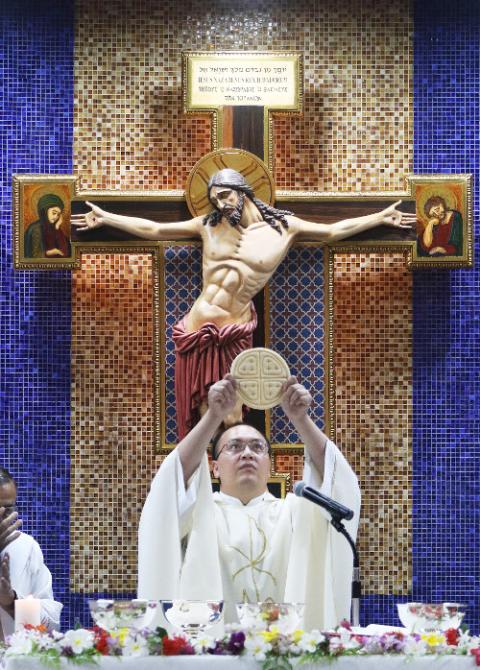
A priest holds up bread during a Neocatechumenal Way Mass. The Way's method of receiving Communion has been criticized as heretical by traditional Catholics. (Honolulu Civil Beat/Cory Lum)
On Saturday evenings in the village of Hagatña, followers of "The Way" carry tambourines, guitars, drums and ukuleles and play lively music in a chapel at the back of the cathedral. The service lasts twice as a long as a typical Mass, with parishioners offering testimonies about their faith and everyone dancing in a circle at the end.
Members include people like Vicky Arriola, a 55-year-old mother of seven, who praises the organization for revitalizing her faith and encouraging her to continue having children, including one with Down syndrome.
Rohr says he started to speak out against Apuron after he removed Fr. Paul Gofigan, a popular Chamorro priest in 2013, because Gofigan had allowed a sex offender to work in the church. A high-ranking cardinal in Rome sent Rohr a letter in October 2013 urging him to stop criticizing Apuron. That only spurred Rohr to speak out more.
Apuron further alienated parishioners the following summer when he removed another popular local priest from his post amid allegations of fiscal mismanagement of a local cemetery. Many like Rohr were also upset that Apuron had decided to allow the Neocatechumenal Way to use a multimillion-dollar church property on the east side of Guam for a seminary. The issue grew so toxic that American Samoan seminarians and Carmelite nuns left Guam.
But Rohr had long been suspicious that Apuron wanted to force the entire archdiocese into the Neocatechumenal Way, particularly since the archbishop sent letters in 2008 to priests insisting that they participate in those services. Started in the 1960s, the organization has been criticized by high-ranking church officials in a number of countries for dividing parishes and violating traditional norms for celebrating Mass.
This map shows where alleged sexual abuse took place throughout Guam. The pins on this map aren't exhaustive, and are only approximate locations. Zoom out to see where Guam is located.
Organizations like Concerned Catholics of Guam and Laity Forward Movement were founded, calling for more fiscal transparency and Apuron's removal.
Meanwhile, Rohr was urging the Vatican to get rid of Apuron, blogging frequently about the archbishop's alleged misdeeds.
That's when Rohr noticed anonymous comments referencing the "Agat boys."
Rohr had heard rumors previously that Apuron sexually abused boys when the archbishop was serving as a priest in Agat.
A California resident named John Toves publicly accused Apuron in 2014 of molesting his cousin, and gained media attention by posting a YouTube video of himself dressed like Apuron and singing. But the alleged victim never came forward. Toves put Rohr in touch with Denton.
"It took me several months really of working up enough trust with Walter to talk to me, but once he started talking to me, I could hear it in his voice," Rohr says. "It's what Apuron did to Walter that set me off."
So Rohr began searching for other former altar boys in Agat who might be willing to go public with their allegations against Apuron. He asked the Concerned Catholics of Guam to take out a full-page ad in the Guam newspaper urging victims to come forward.

Some Catholics on Guam were critical of Archbishop Anthony Apuron for allowing the Neocatechumenal Way to use this seminary in Yona. (Honolulu Civil Beat/Cory Lum)
Confronting the archbishop
Roy Quintanilla was in Hawaii when he got a call from Sondia, his childhood friend, in spring 2016. The two grew up together in Agat and served as altar boys for years.
Sondia convinced Quintanilla to fly to Guam and meet with Rohr, Untalan and others to discuss confronting Apuron. In April 2016, the group met for the first time at Untalan's house to talk about how to confront Apuron. Rohr says he urged the victims to go public with their accusations to help prevent other kids from getting abused.
But it was a risky decision. They had no legal recourse and were worried about getting sued for libel. The group enlisted a lawyer and a publicist to help with the announcements.
Like Sondia, Quintanilla is Chamorro and his childhood revolved around the church. He's the 15th of 16 children. Even though he has lived in Honolulu for most of the last two decades, he still visits home frequently and calls himself Catholic.

Roy Quintanilla stands outside the building that once served as then-Fr. Apuron's living quarters. Quintanilla, in a lawsuit, claims Apuron sexually assaulted him. (Honolulu Civil Beat/Cory Lum)
Quintanilla, 53, who lives in Waikiki and works for a defense contractor, says he was 12 years old when he was molested and he confided the abuse to another priest.
Quintanilla, they decided, would speak out first at a press conference in May 2016 near the church's chancery. Since he was living in Hawaii, his testimony would surprise Apuron. Denton would come forward a few weeks later — "the nuclear bomb because he was raped," says Rohr. Sondia, who works for the local newspaper, would speak out last because he was the most well-known.
"We were just betting that we were going to turn public opinion fast enough to scare Apuron and send him into hiding, which is exactly what he did," Rohr says.
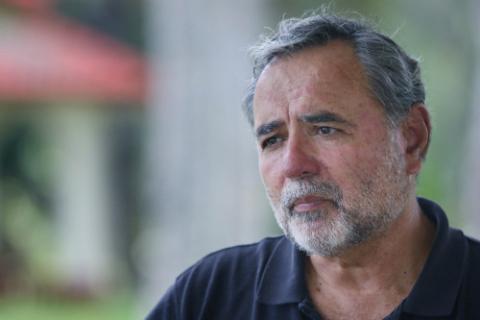
Real estate agent Tim Rohr, a devout Catholic, orchestrated an effort to get former altar boys to go public with their allegations of abuse against Archbishop Apuron. (Honolulu Civil Beat/Cory Lum)
Before he went public, Quintanilla held a family meeting where he told his relatives about his abuse and asked for their support. His niece, Sharleen Santos Bamba, was shocked. She immediately believed her uncle, but initially hesitated when asked to serve as the family spokeswoman because she was afraid it would hurt her professionally.
Bamba was right to brace herself for the impact. The day her uncle came out publicly, "it was like a bomb that rocked the island's core," Bamba says.
Within days, an Arizona resident named Doris Concepcion publicly accused Apuron of molesting her son, Joseph "Sonny" Quinata, when he was growing up in Agat. Sonny was an altar boy at the time of the alleged rape, but he died more than a decade ago in Honolulu. Concepcion told the media that her son told her about the rape as he was being wheeled in for surgery that proved fatal.
Apuron denied the allegations and in a May 31 press release called the accusations "a vicious and calumnious attack" on the archbishop and the church. Quintanilla, Sondia, Denton and Concepcion filed a $2 million defamation lawsuit against Apuron in July.

Street signs across from the cathedral on Guam are another indication of just how deeply Catholicism is woven into the fabric of the island. A block away, the office of the attorney for most plaintiffs is located on Martyr Street. (Honolulu Civil Beat/Cory Lum)
The archbishop left Guam less than a week after Quintanilla's accusation. His lawyer, Jacqueline Terlaje, says he went to Rome to request a canonical process to clear his name and ask that the church appoint someone to assume his responsibilities. Terlaje says Apuron hasn't returned to Guam since and is "at an undisclosed location."
By September, Guam's governor had signed a bill to retroactively get rid of the statute of limitations for civil lawsuits regarding sexual abuse. Soon after the law went into effect, the lawsuits started pouring in.

Altar servers lead a procession out of the church in Piti in honor of the Assumption of Our Lady. (Honolulu Civil Beat/Cory Lum)
Decades of silence
Quintanilla's announcement wasn't the first time that sex abuse allegations surfaced against priests on Guam. Guam Senate President B.J. Cruz was having brunch with his godson in 2005 when the teenager got up abruptly midway through dessert and said he had to leave.
"Why?" Cruz asked.
"Because if I'm late, I would have to go to Pale Ray's room," his godson said.
Cruz immediately alerted the archdiocese that he suspected sexual abuse, but it was another four years before Fr. Ray Cepeda was defrocked for alleged sexual misconduct.
That's when Cruz decided to introduce a bill at the Legislature to lift the statute of limitations. But he says Apuron and other church officials successfully pushed for senators to weaken the bill.
"As we were discussing [the bill] on the floor, my colleagues were actually showing me the caller ID on their phone that it was the archbishop on the phone calling them," Cruz says.
The watered-down bill passed, but Cruz says not a single lawsuit was filed during the two-year window to bring claims.

Street art depicts Pope Francis alongside a sign for a bar in Tumon, Guam's tourism district. (Honolulu Civil Beat/Cory Lum)
Baring a secret
For decades, many of the plaintiffs kept silent about the alleged abuses. Many feared that their devout parents wouldn't believe them, and some waited until their parents and grandparents died before filing lawsuits. The fear of speaking out was compounded by the smallness of Guam, where locals have large extended families and it's impossible not to run into the same people over and over.
"Culture is a reflection of very concrete realities and the concrete reality of Guam is that this is a 30-mile-long island. You're going to bump into people all day long," says Eric Forbes, a Capuchin priest and historian. "So you can't really come out with something embarrassing, something painful, something risky, and never deal with people. You can't do that on Guam."
Still, Forbes isn't surprised so many people are now suing the Catholic Church, because the island's culture is changing. There are more religions compared to decades ago, and there's a movement among some Chamorros to get in touch with their culture separate from the Catholic Church.
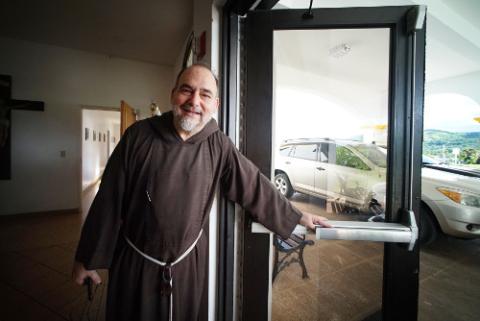
Fr. Eric Forbes says that Chamorro culture is changing and people are leaving the church. (Honolulu Civil Beat/Cory Lum)
"The old culture was you kept it quiet. If Father did something wrong, we just make sure you don't get near that priest. That was the solution," says Forbes. "That's different now."
Some victims have left the church. Anthony Flores, who is also suing Brouillard, goes to social events like novenas — nine days of prayer in honor of a saint — but won't go to ceremonies presided over by a priest.
But for many, the church isn't something they can simply leave.
"I'll be Roman Catholic until the day I die," says J.A., another plaintiff who says he was molested more than 100 times as a child by Fr. Ray Techaira, who is deceased.
J.A. says Techaira first started molesting him on his seventh birthday. Months later, during a fiesta, he says the priest raped him in the rectory.
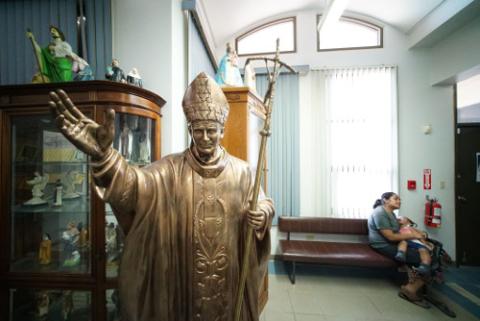
A woman waits with a child behind a statue in the Santa Barbara Catholic Church office in Dededo. (Honolulu Civil Beat/Cory Lum)
J.A. used to scream and cry about going to church after that, but never told his parents or grandparents what happened. His grandfather hung a big crucifix in the hallway and every night at 6 o'clock the family would say the rosary, praying to the Blessed Mother to forgive their sins.
Sometimes, he said, as the priest was raping him in the rectory, his father would be right outside, cleaning the church, oblivious to what was happening.
J.A. now lives in Oregon, in part because living on Guam meant he was surrounded by Catholicism. But he still goes to Mass when he visits family.
"Our Chamorro culture is so ingrained in the Catholic faith I can't ever get away from that. ... It's part of me, it's part of who I am as a Chamorro to maintain my Catholic faith."

The moon sets over the Dulce Nombre de Maria Cathedral Basilica in Hagatña, Guam before a 5:45 a.m. Chamorro Sunday morning Mass. (Honolulu Civil Beat/Cory Lum)
Wariness about the claims
Despite the revelations, many on Guam are skeptical about whether the plaintiffs are telling the truth — and whether they deserve to get money after so much time has passed.
"I think it's just getting out of hand," says a 60-year-old Guam resident named Pete who was having lunch at the Micronesia Mall.
Pete, who declined to give his last name, says that it's unfair to Catholics in Guam that they have to pay for abuse that happened so long ago.
"If this was an ongoing, why just now? Why not 10 years ago? Why do you wait until you're almost my age and then come out?" he says. "I know the bottom line is pretty much money."
The orchestrated nature of the allegations against Apuron helps fuel the doubt, especially among followers of the Neocatachumenal Way who feel scapegoated.

Celebrants sing, dance and play music joyfully during a lively Neocatechumenal Way service in Hagatña. (Honolulu Civil Beat/Cory Lum)
"There are certain factions in our archdiocese that do not want to follow this bishop," says Terlaje, Apuron's attorney. "They do not like this bishop, they do not want this bishop and so they made a concerted effort to get him removed."
She's speaking at her office, which is decorated with photos of the Vatican, the pope and Apuron. In a nod to just how small Guam is, her office is just down the road from Lujan's, the attorney for the vast majority of the plaintiffs. Their offices are separated by the cathedral, which is directly across the street from the Legislature.

Jacqueline Taitano Terlaje, Apuron's attorney, points to a painting of the Vatican in her office. (Honolulu Civil Beat/Cory Lum)
"If God has a desire to burn down the church of Guam, he's going to burn down the church of Guam."
— Jaqueline Terlaje
Jaqueline Terlaje, Apuron's attorney, says Apuron has been judged guilty without a trial.
Terlaje says she's frustrated with so many people calling for Apuron to be defrocked before his trials have even started.
"It was as if he isn't entitled to anything, he should not be given any due process rights whatsoever," she says.
She's also skeptical that only four people have accused Apuron of molestation. If he were a predator, she asks, there would be more alleged victims, wouldn't there?
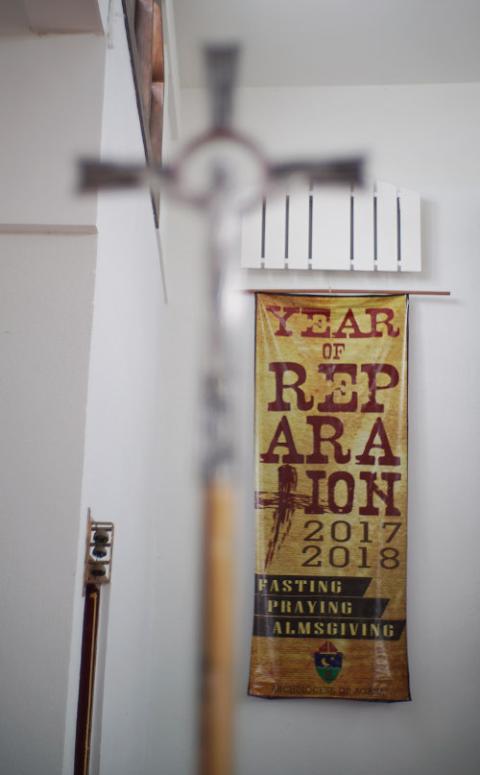
A banner proclaims 2017-2018 the Year of Reparation inside Mount Carmel Church in Agat, Guam, where Quintanilla and Sondia were once altar boys. (Honolulu Civil Beat/Cory Lum)
Finding healing in caring
Quintanilla, the Honolulu resident, says he's felt an outpouring of support, especially from his family.
He's particularly glad that the Vatican gave Apuron's responsibilities to a new archbishop, Michael Byrnes, who is striking a more conciliatory tone.
The church declared 2017-2018 a Year of Reparation and set up an organization called Hope and Healing that's offering counseling to sex abuse victims. Walking through the Mount Carmel Church in Agat where he was an altar boy, Quintanilla is touched to see a photo with a message from Pope Francis.
"Words cannot fully express my sorrow for the abuse you suffered," states the quotation on the image.
Three nights later, his niece Bamba leads the rosary for Quintanilla and her other family members. They're sitting before a table crowded with photos of Quintanilla's little brother who died last year, along with pictures of other relatives who died. A tall candle with the image of Jesus flickers.
It's the sixth day of the first-year anniversary rosary for Quintanilla's brother who lived with him in Hawaii. Quintanilla says that taking care of his little brother, who had Down syndrome, is part of what rescued him from his childhood trauma and resulting depression.
After the rosary, everyone kisses each other and lines up for empanadas, lumpia and red rice. As he waits for food, Quintanilla's older brother Anthony says he is glad that Roy finally spoke out after all those years.
"You cannot hide all of this anymore," Anthony says.

Roy Quintanilla during rosary held for his younger brother who died last year and another elder brother who passed away. (Honolulu Civil Beat/Cory Lum)
In search of closure
At Asan Beach on a sticky summer afternoon, a group of church members and activists gather for a barbecue lunch, dancing and celebration.
Lou Klitzke, who founded a group called the Laity Forward Movement, hands out badges to members to thank those who protested against Apuron in front of the cathedral. Now that he's been largely replaced, they're happy and ready to focus on getting the Neocatechumenal Way out of Guam.
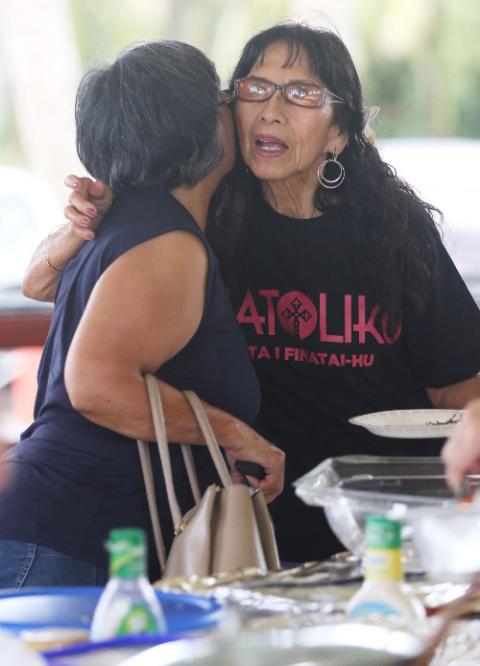
Lou Klitzke hugs a friend on Guam during a barbecue honoring people who protested against Apuron in front of the cathedral every Sunday for more than a year. (Honolulu Civil Beat/Cory Lum)
Like several others, Klitzke is wearing a pink shirt that says,"Katoliko Asta i Finatai-hu," a Chamorro phrase that means "Catholic until I die."
But for B.J., there's no feeling of accomplishment. Only the pain of the memories, and confusion about whether he's doing the right thing.
He wonders if he made a mistake by speaking out. "Am I going to go to hell?" he asks. "Lord, am I betraying my faith in you?"
He's losing his struggle with cancer, and he doesn't go to Mass as often because of his sickness. He wonders if God will understand why he doesn't go to confession anymore.
"To this day, I'm still trying to find closure," he says.
Hearing the sound of the river's rushing water takes him back in time, and he's still angry, questioning why this happened to him.
Yet he also reminisces nostalgically about antigu, the old days when life on Guam was simpler and the island was smaller, less developed and more connected. He worries about the children today and, even as one of the plaintiffs, is shocked by the rate at which the lawsuits are being filed against the church.
"When the Judgment Day comes, I don't know if the Lord might say I'm wrong."
— B.J.
"The Vatican has to do something about it," he says. That's the main reason why he decided to file a claim, even though he's terrified people will discover his identity.
"If I'm going to die, I'm going to die knowing, you know, that I will be leaving this world, that I leave nothing but the truth."
Editor's note: Two of the plaintiffs, who requested their full names not be used, are identified by their initials. Both filed their lawsuits under their initials.
[Anita Hofschneider is a reporter for Civil Beat. You can reach her by email at anita@civilbeat.org or follow her on Twitter at @ahofschneider.]







